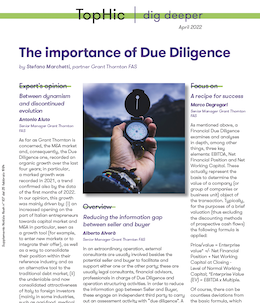-
Transactional advisory services
Find out more about the transactional advisory services of Grant Thornton Financial Advisory Services
-
Valuations
Find out more about the valuations services of Grant Thornton Financial Advisory Services
-
Mergers and acquisitions
Find out more about the merger and acquisition services of Grant Thornton Financial Advisory Services
-
Forensic and investigation services
Find out more about the forensic and investigation services of Grant Thornton Financial Advisory Services
-
Recovery & reorganisation
Find out more about the Recovery & reorganisation services of Grant Thornton Financial Advisory Services
-
Business risk services
Find out more about the business risk services of Grant Thornton Financial Advisory Services
-
Business consulting
Find out more about the business consulting services of Grant Thornton Financial Advisory Services
-
Capital market
Capital market
-
Corporate and business tax
Find out more about our corporate and business tax services.
-
Direct international tax
Find out more about our direct international tax services.
-
Global mobility services
Find out more about our global mobility services.
-
Indirect international tax
Find out more about our indirect international tax services.
-
Transfer pricing
Find out more about our transfer pricing services.
-
Litigation
Our lawyers and accountants can manage all defense measures provided not only by the Italian law, but also by EU regulations and conventions
-
Family business
Find out more about our Family business services.
-
Legal
The client can be assisted in every need and with the same care both on important operations or disputes and on simple matters

-
Back office outsourcing
Find out more about our Back office outsourcing services
-
Business process outsourcing
Find out more about our business process outsourcing services.
-
Compilation of financial statements
Find out more about our compilation of financial statements services.
-
Tax compliance
Find out more about our tax compliance services.
-
Electronic invoicing
Find out more about our electronic invoicing services
-
Electronic storage
Electronic storage is an archiving procedure that guarantees the legal validity of a digitally stored electronic document
-
Revaluation of corporate assets
Find out your civil and fiscal revaluation of tangible, intangible and financial assets
-
Human resources consulting
Find out more about our human resources consulting services.
-
Payroll
Find out more about our payroll services.
-
HR News
HR News the monthly information newsletter by Grant Thornton HR
-
Cybersecurity
GT Digital helps clients structure information security management internal functions, also through partially or totally outsourced functions
-
Agile and Programme Management
GT Digital provides support in the adoption and implementation of different portfolio management
-
Robotic Process Automation
Our “BOT Farm” can rely on digital workers able to help clients in routine activities, allowing employees to deal with more added-value activities
-
Data strategy and management
GT Digital can support clients in seizing the opportunities offered by Big Data, from the definition of strategies to the implementation of systems
-
Enterprise Resource Planning
We support clients in selecting the most appropriate ERP System according to their specific needs, helping them also understand licensing models
-
IT strategy
GT Digital supports clients in making strategic choices, identifying innovation opportunities, comparing themselves with competitors
-
IT service management
We can support with software selection and with the implementation of dedicated tools for the management of ICT processes
-
DORA and NIS 2
The entry into force of the DORA Regulation and NIS2 represents a major step towards the creation of a harmonised regulatory framework
As mentioned above, a Financial Due Diligence examines and analyses in depth, among other things, three key elements: EBITDA, Net Financial Position and Net Working Capital. These actually represent the basis to determine the value of a company (or group of companies or business unit) object of the transaction.
Typically, for the purposes of a brief valuation (thus excluding the discounting methods of prospective cash flows) the following formula is applied:
Price/value = Enterprise value* +/- Net Financial Position + Net Working Capital at Closing - Level of Normal Working Capital
* Enterprise Value (EV) = EBITDA x Multiple
Of course, there can be countless deviations from the basic formula, which depend on the intrinsic characteristics of the company being analysed or by the specific features of a given industry. Actually, additional elements are often added to the formula above, such as for example surplus assets (real estate and assets which did not generate EBITDA in the reference period).
Without entering into the details of valuation theory, we can define EV as the “gross” value of the company under analysis, which depends on its profitability, EBITDA, and on the market multiple, which is a summary of several elements which the investor considers with reference to a specific company operating in a given industry. EV can be defined as the “gross” value of the company, since it does not consider its capital structure, i.e. the mix of risk capital and of debt financing corporate activities.
To this end, it is key to analyse the net financial position and the net working capital in order to determine the company’s equity value (i.e. the price for 100% of the company).
For the reasons above, the Financial Due Diligence focuses on the analysis of the EBITDA, of the Net Financial Position and on the Net Working Capital dynamics.
Analysis of the normalised EBITDA
The key question when analysing EBITDA is: “Is the EBITDA resulting from the accounts representative of the company’s ability to generate income?”.
Here’s where Due Diligence comes into play: starting from the EBITDA, as resulting from the corporate accounts, it identifies all those distorting elements to be included and excluded, thus leading to the normalised EBITDA, i.e. the most representative indicator of the company’s situation and of more interest to the buyer and to the other subjects involved (e.g. the funders of the operation).
Determining the normalised EBITDA means identifying all cost and revenue items which have a distorting effect thereon, which can be divided into four groups:
- accounting elements - these concern distortions of the EBITDA due to accounting errors or to the peculiarity of some accounting rules or principles. The typical example is lease accounting: according to the Italian accounting standards, a lease is reported in the accounts as if it were an operating element, whereas according to the valuation and M&A praxis, a lease is considered as a financing method and thus a liability, leading to the exclusion of lease rentals from the EBITDA;
- non recurring or terminating elements - in the life of a company there can be countless cases of non-recurring costs or revenues, for example restoration cost after an exceptional weather event or a grant received;
- normalisations - this is the case of values correctly reported in the accounts but which, for their nature, may positively or negatively impact the EBITDA of a given year. The typical example is the write down of bad debts: a company may write down in a single FY a significant number of receivables accrued over more years, negatively impacting the EBITDA of that FY and implicitly benefitting the other FYs;
- pro-forma accounts: this is the exclusion or inclusion of revenues/costs which are not reflected in the current perimeter of the operation, but which will be in the future. This is the case for example of a production line which is going to be terminated, or of a line operating only in the last few months of the FY considered for the Due Diligence.
The analysis of all these elements leads to determine the normalised EBITDA.
It is worth underling that the Financial Due Diligence is not limited to this economic analysis. The key elements of the company’s profitability are also analysed, such as the trend and concentration of revenues, the marginality of products and services and fixed overheads. There are many types of analyses which can be carried out depending on the industry and on the specific features of the company considered.
The analysis of the Net Financial Position (or NFP)
The Net Financial Position is the sum of financial liabilities net of cash and cash equivalents. Nonetheless, within an M&A operation, there are a series of elements which impact this value, and also in this case the indicator is called normalised NFP.
A Financial Due Diligence aims at identifying the elements which can be included in the calculation of the NFP, namely cash-like items, i.e. items similar to cash which improve thr NFP and debt-like items, i.e. elements which worsen the NFP as they are comparable to payables.
Among cash-like items are for example investment in short-term financial instruments.
Among debt-like items, instead, are all debt items which can be considered as financial liabilities; a typical example is overdue trade payables. Moreover, it is important to consider the off-balance sheet items, which do not appear in the corporate accounting or financial statements. These are the future disbursements which the investor will have to bear after acquiring a shareholding in the corporate capital. The most common example is probably the operating lease debt recorded in the accounts basing on Italian accounting principles, as mentioned above.
In principle, all the items excluded from the EBITDA are included in the calculation of the normalised NFP, whereas all items included in the EBITDA (net of assets and surplus assets/liabilities) is part of the Net Working Capital.
Analysis of the seasonality of the normalised Net Working Capital
The Net Working Capital (or NWC) is defined as the algebraic sum of trade receivables, trade payables, stocks and other current receivables and payables. The NWC dynamics are very important as they have a direct impact on the company’s cash. We can actually say that the NWC mirrors the company’s cash, i.e. the changes therein are diametrically opposite to cash flows.
For example, the Net Working Capital of a company operating in an industry characterised by a marked seasonality will be strongly influenced by its business, depending on the timing of its sales and supplies. The seasonality impacts the amount of funds available in a given moment and consequently the company’s NFP, the latter being a snapshot of the corporate situation at a specific moment in time.
Therefore, buyer and seller could benefit or suffer from the fact that the company has a low NWC (higher cash) or a surplus NWC (lower cash).
The Financial Due Diligence focuses on these aspects to understand the NWC profile (and, thus, the cash profile) of the company being transacted, in order to define a mechanism which can grant a fair price for the transaction, not influenced by the effects of the business seasonality.
In general, a reference NWC level is established through a cash compensation mechanism based on the NWC value at the closing of the transaction. Two different scenarios are possible: (i) an adjustment in favour of the buyer if the NWC is lower than the reference one, and (ii) an adjustment in favour of the seller if the NWC is higher that the reference one.

